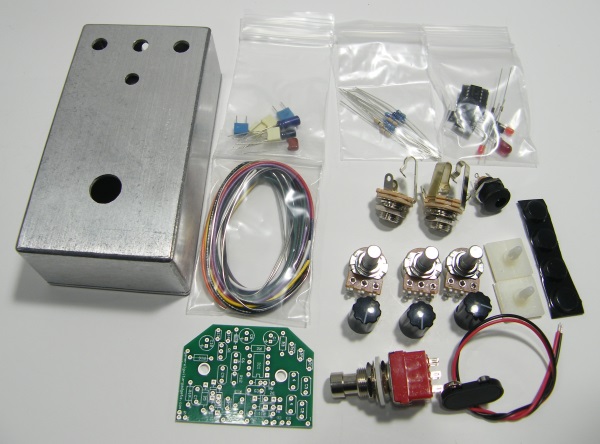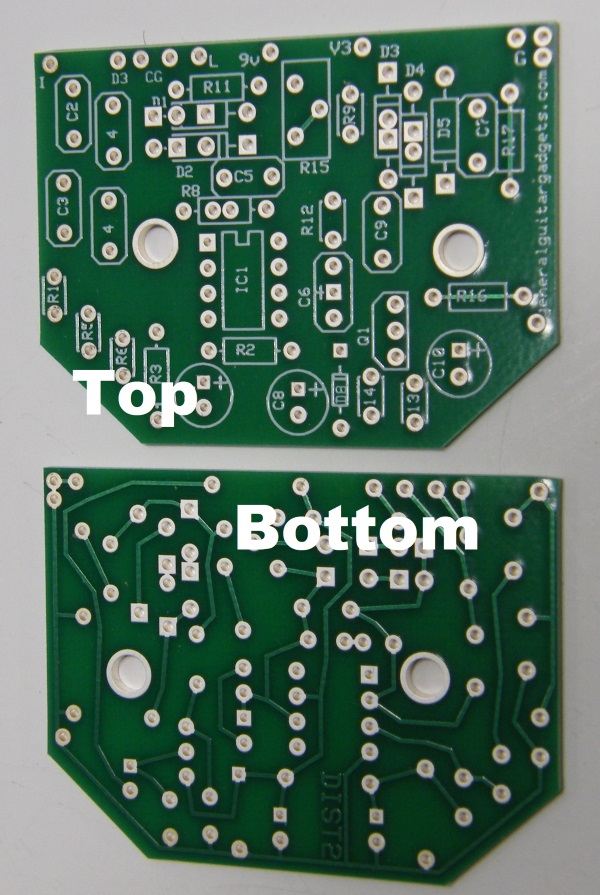Red Fuzz
This is the Red Fuzz project based on the schematic from Robin Tomtlund’s Effects. This is a very nice distortion pedal (even though then name says “Fuzz”). similar in some ways to the DOD 250 Overdrive but with a very nice “Rat-Style” tone control.
- General Build Instructions
- Red Fuzz Instructions
- Red Fuzz Bill of Materials
- Red Fuzz Schematic
- Red Fuzz Parts Layout and Wiring Diagram
- Red Fuzz Ready-For-Transfer Printed Circuit Board Layout
- Red Fuzz Addition Information – Provided by Tobias Karlsson. These diagrams show the IC and transistor pinouts and voltages. Thanks Tobias!
- Red Fuzz Modification – Diode switching mod by Tobias Karlsson.
- Red Fuzz Project History File
Buy a Red Fuzz Complete Kit. Includes all the parts and materials you need to build one, all for about the price you would pay for a PCB and parts.

Would you like a Ready to Solder Circuit Board for this project? Note: the PCB for this project is called the “Distortion 2” PCB. Note also: If you buy the kit, the Ready-to-Solder Circuit Board (RTS PCB) is included in the kit. You do not need to purchase this RTS PCB if you buy the kit.

Here are some sound files of this effect, contributed by Tobias Karlsson.
Notes from Tobias about the sound files:
Red Fuzz LEDS – Fender Stratocaster (single coils, rosewood fingerboard) using bridge or neck coil with full volume and tone, into the “Red Fuzz” with full “Tone” (towards the treble) and full “Intensity”, into a Marshall Super Lead 100w -72 with 4×12″ cab with “greenbacks”. Recording mic is Shure SM57 (a rather close up to the cab)
Red Fuzz SILICON – Same setup as with the LEDS recording except for instead of LED’s, there are two 1N4148 silicon diodes.
No distortion is created by the amp and recording volume was quite low. No “EQ-ing” in the computer or any kind of effects anywhere as I think that’s a fair way to demonstrate an effect pedal. I tried to play in the same style in both recordings and using almost the same licks so a comparison can be made easy between them. When using it with the LEDs and turning down “Intensity” it could be used to boost up some distortion in the amp, using it as a semi clean booster, the output is “big”. And of course, the noise level is bigger when using the silicon (and output is smaller) but I didn’t record that as I thought it depends to much of the amp what sound that will produce. I?m not sure if I made the “Red Fuzz” justice with my recording and guitar playing but I hope you find the samples useful anyway, at least you get an idea about how it sounds. I didn’t have so much time experimenting where to place the mic to get the best tone (or so the tone that is coming out in your stereo receiver got the same “feel” that you’re hearing when you’re playing through your amp).

